THIS PRODUCT IS OBSOLETE. Show more about end-life-products policy.
Recommended product:
Product:
M4x.4410-x4
16 bit high speed digitizer
Description:
The M4x.44xx-x4 series digitizers deliver the highest performance in both speed and resolution. The series includes PCIe cards with either two or four synchronous channels where each channel has its own dedicated ADC. The ADC’s can sample at rates from 130 MS/s up to 500 MS/s and are available with either 14 bit or 16 bit resolution. The combination of high sampling rate and resolution makes these digitizers the top-of-the-range for applications that require high quality signal acquisition.
Facts & Features:
- 130 MS/s on 2 channels
- Simultaneously sampling on all channels
- Separate ADC and amplifier per channel
- Up to 3 synchronous digital channels with multi-purpose I/O
- 2 GSample on-board memory as standard
- 6 input ranges: +/-200 mV up to +/-10 V
- Window, re-arm, OR/AND trigger
- PXIe x4 Gen 2 Interface
- Sustained streaming mode more than 1.7 GB/s
- Works with all PXIe and PXI hybrid slots
- PXIe 3U format, 2 slots wide
Product-Video:
Application examples:
- High Energy Physics
- Research and Development
- Radar
- Spectroscopy
- Laser Applications

The ABA mode combines slow continuous data recording with fast acquisition on trigger events. The ABA mode works like a slow data logger combined with a fast digitizer. The exact position of the trigger events is stored as timestamps in an extra memory.

FIFO mode
The FIFO mode is designed for continuous data transfer between measurement board and PC memory or hard disk. The read (acquisition) transfer rate reached depends on the motherboard and can be up to 1.7 GByte/s on a PXI Express x4 Gen2 slot. The control of the data stream is done automatically by the driver on interrupt request. The complete installed on-board memory is used for buffer data, making the continuous streaming extremely reliable.


Boxcar Average
The Boxcar averaging function smooths out high frequency noise to give a clear signal. It is most useful in situations where signals have been oversampled and it can be used to increase vertical resolution, lower noise and improve dynamic characteristics such as signal-to-noise ratio (SNR) and spurious free dynamic range (SFDR). It uses a mathematical signal processing function to effectively recalculate the vertical value of each acquired data point by averaging it with adjacent sample points.
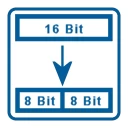
The digitizer allow to optionally reduce the resolution of the A/D samples from their native resolution down to 8 bit resolution, such that each sample will only occupy one byte in memory instead of the standard two bytes required. This does not only allow to store douple the amount of samples in the on-board memory, but also reduces the required bandwidth over the PCIe bus by half and also to the storage
devices, such as SSD or HDD. Using this mode much higer streaing speeds are reachable.
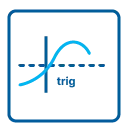
Channel Trigger
The data acquisition boards offer a wide variety of trigger modes. Besides the standard signal checking for level and edge as known from oscilloscopes it's also possible to define a window trigger. Trigger conditions can be combined with logical conjunctions like OR to adopt to different application scenarios.
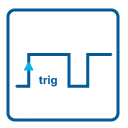
External Trigger
All boards can be triggered using a separate external trigger signal with a two level programmable window comparator and a second separate external trigger with a single programmable level comparator. It's possible to use positive or negative edge. An internally recognized trigger event can - when activated by software - be routed to a multi purpose i/o connector to start external instruments.



Timestamp
The timestamp option writes the time positions of the trigger events in an extra memory. The timestamps are relative to the start of recording, a defined zero time, externally synchronized to a radio clock, or a GPS receiver. With this option acquisitions of systems on different locations can be set in a precise time relation.
High Precision PLL
The internal sampling clock of the card is generated using a high precision PLL. This powerful device allows to select the sampling rate with a fine step size making it possible to perfectly adopt to different measurement tasks. Most other cards on the market only allow the setup of fixed sampling rates like 100 MS/s, 50 MS/s, 25 MS/s, 10 MS/s, ... without any possibility to set the sampling rate to any value in between.
Reference Clock
The option to use a precise external reference clock (normally 10 MHz) is necessary to synchronize the board for high-quality measurements with external equipment (like a signal source). It's also possible to enhance the quality of the sampling clock in this way. The driver automatically generates the requested sampling clock from the fed in reference clock.
Selectable AC/DC Coupling
Each analog channel contains a software selectable AC/DC coupling. When using the DC coupling all frequency parts of the signal including the DC offset are acquired. Selecting the AC coupling will only acquire frequency parts of the signal that are above a defined minimum bandwidth.
On-board Calibration
The on-board calibration can be run on user request and calibrates the amplifier against a dedicated internal high precision calibration source. After this calibration data is stored permanently in an on-board EEPROM and is automatically used for further acquisitions.

Programmable Input Amplifiers
The analog inputs can be adapted to real world signals using a wide variety of settings that are individual for each channel. By using software commands the input termination can be changed between 50 Ohm and 1 MOhm and one can select an input range matching the real world signal.Selectable Input Path
For each of the analog channels the user has the choice between two analog input paths, both offering the highest flexibility when it comes to input ranges. The Buffered path has 1 MOhm termination that allows to connect standard oscilloscope probes to the card. The HF path on the other hand provides the highest bandwidth and the best signal integrity having a fixed 50 Ohm termination.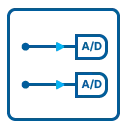
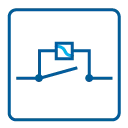
Selectable Low Pass Filter
Each analog channel contains a software selectable low-pass filter to limit the input bandwidth. Reducing the analog input bandwidth results in a lower total noise and can be usefull especially with low voltage input signals.
Multi Purpose I/O
All M4i cards offer three universal multi purpose I/O lines, which can be separately programmed as either input or output. When used as outputs, these lines can be used to output card status signals like trigger-armed or to output the trigger to synchronize external equipment.






This standard driver is included in the card delivery and it is possible to get the newest driver version free of charge from our homepage at any time. There are no additional SDK fees for the classical text-based programming. All boards are delivered with drivers for Windows 7, Windows 8, Windows 10 and Windows 11, all 32 bit and 64 bit.
| Product | Channels | Max. Samplerate | Max. Bandwidth |
|---|---|---|---|
| M4x.4411-x4 | 4 | 130 MS/s | 65 MHz |
| M4x.4420-x4 | 2 | 250 MS/s | 125 MHz |
| M4x.4421-x4 | 4 | 250 MS/s | 125 MHz |
| M4x.4450-x4 | 2 | 500 MS/s | 250 MHz |
| M4x.4451-x4 | 4 | 500 MS/s | 250 MHz |
| M4x.4470-x4 | 2 | 180 MS/s | 125 MHz |
| M4x.4471-x4 | 4 | 180 MS/s | 125 MHz |
| M4x.4480-x4 | 2 | 400 MS/s | 250 MHz |
| M4x.4481-x4 | 4 | 400 MS/s | 250 MHz |
| On different platforms | Bus | Max. Bus Transfer speed |
|---|---|---|
| DN2.441-02 | Ethernet | 70 MByte/s |
| M4i.4410-x8 | PCI Express x8 | 3000 MByte/s |

Documents
Signal Processing fro Digitizers |
21.02.2022 | 1 M | ||
Application Note: Intoduction to PXIe and PXI |
21.02.2022 | 656 K | ||
Windows driver installation of driver versions < 4.0 |
21.02.2022 | 1 M | ||
Datasheet of the M4x.44xx-x4 PXIe Digitizer Series |
23.02.2024 | 1 M | ||
Manual of M4i.44xx / M4x.44xx family |
23.02.2024 | 12 M | ||
M4 Series Firmware Option Datasheet: Block Average |
21.02.2022 | 348 K | ||
M4 Series Firmware Option Data sheet: Block Statistics (Peak Detect) |
21.02.2022 | 293 K | ||
Data sheet of SPA pre-amplifier |
08.12.2023 | 580 K | ||
Short Manual for IVI Driver |
21.02.2022 | 532 K | ||
Manual for LabVIEW drivers for M4i / M4x |
08.12.2023 | 6 M | ||
Manual for MATLAB driver M2p/M4i/M4x/M5i/M2i/M3i/DN2/DN6 |
13.12.2023 | 1 M | ||
SCAPP Manual |
08.12.2023 | 618 K |
WINDOWS DRIVER + SOFTWARE
M2p/M4i/M4x/M5i/M2i/M3i/DN2/DN6 driver for Windows 7, 8, 10, 11 (32/64 bit) |
7.00 | 23.02.2024 | 5 M | |
M2i/M3i/M4i/M4x driver - last Version for Windows 32 XP / Vista |
3.30 | 21.02.2022 | 2 M | |
M2i/M3i/M4i/M4x driver - last Version for Windows 64 XP / Vista |
3.20 | 21.02.2022 | 3 M | |
C/C++ driver header and library files |
7.00 | 23.02.2024 | 43 K | |
Spectrum Control Center (32-bit) / Windows 7, 8, 10 |
2.35 | 23.02.2024 | 22 M | |
Spectrum Control Center (64-bit) / Windows 7, 8, 10, 11 |
2.35 | 23.02.2024 | 25 M | |
Spectrum Control Center - last Version for Windows XP |
1.74 | 21.02.2022 | 8 M | |
SBench 6 (32-bit) Installer / Windows 7, 8, 10 |
6.5.07 | 23.02.2024 | 36 M | |
SBench 6 (64-bit) Installer / Windows 7, 8, 10, 11 |
6.5.07 | 23.02.2024 | 39 M | |
SBench6 - last Version for Windows XP |
6.3.5 | 21.02.2022 | 41 M | |
Windows Installer for Remote Server Option |
23.02.2024 | 13 M | ||
IVI Driver for IVI Digitizer class (32 bit) |
23.02.2024 | 3 M | ||
IVI Driver for IVI Scope class (32 bit) |
23.02.2024 | 3 M | ||
M2i/M2p/M3i/M4i/M4x/M5i/DN2/DN6 LabView driver installer |
23.02.2024 | 19 M | ||
M2p/M4i/M4x/M5i/M2i/M3i/DN2/DN6 Matlab driver + examples installer |
23.02.2024 | 7 M | ||
Windows Examples (C/C++, .NET, Delphi, Java, Python, Julia ...) |
7.00 | 23.02.2024 | 2 M |
LINUX DRIVER + SOFTWARE
M2p/M4i/M4x/M5i/M2i/M3i drivers (Kernel + Library) for Linux 32 bit and 64 bit |
7.00 | 23.02.2024 | 12 M | |
Driver libraries (no Kernel) for Linux 32 bit and 64 bit |
7.00 | 23.02.2024 | 9 M | |
Spectrum Remote Server Linux Installer Package |
23.02.2024 | 12 K | ||
Spectrum Control Center |
2.35 | 07.03.2024 | 57 M | |
SBench 6 Linux 32 (.rpm) |
6.5.07 | 23.02.2024 | 26 M | |
SBench 6 Linux 64 (.rpm) |
6.5.07 | 23.02.2024 | 26 M | |
SBench 6 Linux 32 (.deb) |
6.5.07 | 23.02.2024 | 23 M | |
SBench 6 Linux 64 (.deb) |
6.5.07 | 23.02.2024 | 22 M | |
SBench6 Jetson (.deb) |
6.5.07 | 23.02.2024 | 8 M | |
Drivers + examples for MATLAB for Linux (DEB + RPM) |
23.02.2024 | 183 K | ||
Linux Examples (C/C++, Python, Julia ...) |
7.00 | 23.02.2024 | 556 K |
Firmware
M2i/M2p/M3i/M4i/M4x/M5i firmware update (Windows) |
23.02.2024 | 22 M | ||
M2i/M2p/M3i/M4i/M4x/M5i firmware update (Linux) |
23.02.2024 | 30 M |
Case Studies
| OCT Skin Cancer Scanner | OCT application for skin cancer diagnosis |
21.02.2022 | 351 K | |
| CS Mass Spectroscopy | Case Study: Digitizer in Mass Spectroscopy |
21.02.2022 | 533 K | |
| CS Spectrum Digitizers at DESY | Case Study: Spectrum Digitizers playing vital role at DESY |
21.02.2022 | 982 K |
Product Notes
| General Digitizer Introduction | General Introduction to Waveform Digitizers |
21.02.2022 | 587 K | |
| High-Res High BW Digitizers | Advantages of High Resolution in High Bandwidth Digitizers |
21.02.2022 | 2 M | |
| Digitizer Acquisition Modes | Using modular Digitizer Acquisition Modes |
21.02.2022 | 3 M | |
| Digitizer Front-End | Proper Use of Digitizer Front-End Signal Conditioning |
21.02.2022 | 3 M | |
| Trigger and Sync | Trigger, Clock and Synchronization Details at high-speed Digitizers |
21.02.2022 | 1 M | |
| Digitizer Software Integration | Software Support for Modular Digitizers |
21.02.2022 | 724 K | |
| SBench 6 Introduction | SBench 6 - Data Acquisition and Analysis of Digitizer Data |
21.02.2022 | 1 M |
Application Notes
| Ultrasonic Applications | Using Digitizers in Ultrasonic Applications |
21.02.2022 | 617 K | |
| RF Measurements | RF Measurements using a modular Digitizer |
21.02.2022 | 838 K | |
| Signal Processing Tools | Using Signal Processing Tools to enhance Digitizer Data |
21.02.2022 | 1 M | |
| Mechanical Measurements | Mechanical Measurements Using Digitizers |
21.02.2022 | 1 M | |
| Using Probes & Sensors | Using Probes and Sensors with Modular Digitizers |
21.02.2022 | 858 K | |
| Digitizers as Oscilloscope | Using a Digitizer as Oscilloscope |
21.02.2022 | 845 K | |
| Solving Data Transfer Bottlenecks on Digitizers | Solving Data Transfer Bottlenecks on Digitizers |
21.02.2022 | 2 M | |
| Teaming AWG with Digitizer | Teaming an Arbitrary Waveform Generator with a Modular Digitizer |
21.02.2022 | 919 K | |
| Common Digitizer Setup Problems | Application Note: Common Digitizer Setup Problems to avoid |
21.02.2022 | 1 M | |
| Mass Spectroscopy | Application Note Mass Spectroscopy |
21.02.2022 | 879 K | |
| AN LIDAR Light Detection and Ranging | Application Note LIDAR - Light Detection and Ranging |
21.02.2022 | 528 K | |
| AN Amplitude Resolution | Application Note: The Amplitude Resolution of Digitizers and how it affects Measurements |
21.02.2022 | 555 K | |
| AN Radar Signal Acquisition | Application Note: Radar Signal Acquisition with Modular Digitizer |
21.02.2022 | 771 K | |
| AN Dynamic Parameters and Digitizers | Application Note: Dynamic Parameters and Waveform Digitizers |
21.02.2022 | 711 K | |
| AN Characterization of RKE devices | Application Note: Characterization of Remote Keyless Entry device |
21.02.2022 | 1 M | |
| AN008 Install Legacy Win Drivers | Application Note: Legacy Windows Driver Installation |
21.02.2022 | 1 M | |
| Aircraft Systems Testing | Testing electronic aircraft systems using modular instruments |
21.02.2022 | 3 M |
White Papers
| Software block averaging | Using software based fast block averaging |
21.02.2022 | 649 K | |
| Boxcar Average Function | White Paper 44xx Series Boxcar Average Function |
21.02.2022 | 797 K |


